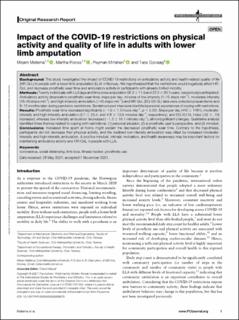| dc.contributor.author | Mellema, Mirjam | |
| dc.contributor.author | Risnes, Martha | |
| dc.contributor.author | Mirtaheri, Peyman | |
| dc.contributor.author | Gjøvaag, Terje | |
| dc.date.accessioned | 2022-02-18T14:32:32Z | |
| dc.date.available | 2022-02-18T14:32:32Z | |
| dc.date.created | 2021-12-22T10:53:48Z | |
| dc.date.issued | 2021-12-14 | |
| dc.identifier.issn | 0309-3646 | |
| dc.identifier.issn | 1746-1553 | |
| dc.identifier.uri | https://hdl.handle.net/11250/2980105 | |
| dc.description.abstract | Background: This study investigated the impact of COVID-19 restrictions on ambulatory activity and health-related quality of life (HR-QoL) in people with a lower limb amputation (LLA) in Norway. We hypothesized that the restrictions would negatively affect HR-QoL and decrease prosthetic wear time and ambulatory activity in participants with already limited mobility. Methods: Twenty individuals with LLA (age and time since amputation 56.2 ± 11.9 and 22.3 ± 20.1 years, respectively) participated. Ambulatory activity (stepwatch: prosthetic wear time; steps per day; minutes of low-intensity (1–15 steps min-1), moderate-intensity (16–40 steps min-1), and high-intensity ambulation (>40 steps min-1)) and HR-QoL (EQ-5D-5L) data were collected prepandemic and 8–12 months later during pandemic restrictions. Semistructured interviews identified personal experiences of coping with restrictions. Results: Prosthetic wear time decreased significantly (−1.0 ± 1.5 hours day-1, p < 0.05). Steps per day (440 ± 1481), moderate-intensity and high-intensity ambulation (3.7 ± 23.4, and 4.8 ± 13.9 minutes day-1, respectively), and EQ-5D-5L index (.02 ± .10) increased, whereas low-intensity ambulation decreased (−1.5 ± 16.1 minutes day-1), all nonsignificant changes. Qualitative analysis identified three themes related to coping with restrictions: (1) personal situation, (2) a prosthetic user’s perspective, and (3) mindset. Conclusions: Increased time spent at home might explain the decreased prosthetic wear time. Contrary to the hypothesis, participants did not decrease their physical activity, and the declined low-intensity ambulation was offset by increased moderate-intensity and high-intensity ambulation. A positive mindset, intrinsic motivation, and health awareness may be important factors for maintaining ambulatory activity and HR-QoL in people with LLA. | en_US |
| dc.description.sponsorship | The authors disclosed receipt of the following financial support for the research, authorship, and/or publication of this article: This work was financially supported by the Research Council of Norway and Oslo Metropolitan University/Faculty of Technology, Art, and Design/Faculty of Health Sciences. The funded Project is “Patient-Centric Engineering in Rehabilitation (PACER)” and project No. is 273599 | en_US |
| dc.language.iso | eng | en_US |
| dc.publisher | Lippincott, Williams & Wilkins | en_US |
| dc.relation.ispartofseries | Prosthetics and orthotics international; | |
| dc.relation.uri | https://journals.lww.com/poijournal/Abstract/9000/Impact_of_the_COVID_19_restrictions_on_physical.99902.aspx | |
| dc.rights | Attribution-NonCommercial-NoDerivatives 4.0 Internasjonal | * |
| dc.rights.uri | http://creativecommons.org/licenses/by-nc-nd/4.0/deed.no | * |
| dc.subject | Coronavirus | en_US |
| dc.subject | Social distancing | en_US |
| dc.subject | Limb losses | en_US |
| dc.subject | Fitness trackers | en_US |
| dc.subject | Prosthetic use | en_US |
| dc.title | Impact of the COVID-19 restrictions on physical activity and quality of life in adults with lower limb amputation | en_US |
| dc.type | Peer reviewed | en_US |
| dc.type | Journal article | en_US |
| dc.description.version | publishedVersion | en_US |
| dc.rights.holder | © 2021 The Authors | en_US |
| cristin.ispublished | true | |
| cristin.fulltext | original | |
| cristin.qualitycode | 1 | |
| dc.identifier.doi | https://doi.org/10.1097/PXR.0000000000000078 | |
| dc.identifier.cristin | 1971376 | |
| dc.source.journal | Prosthetics and orthotics international | en_US |
| dc.source.pagenumber | 1-7 | en_US |
| dc.relation.project | Norges forskningsråd: 273599 | en_US |

